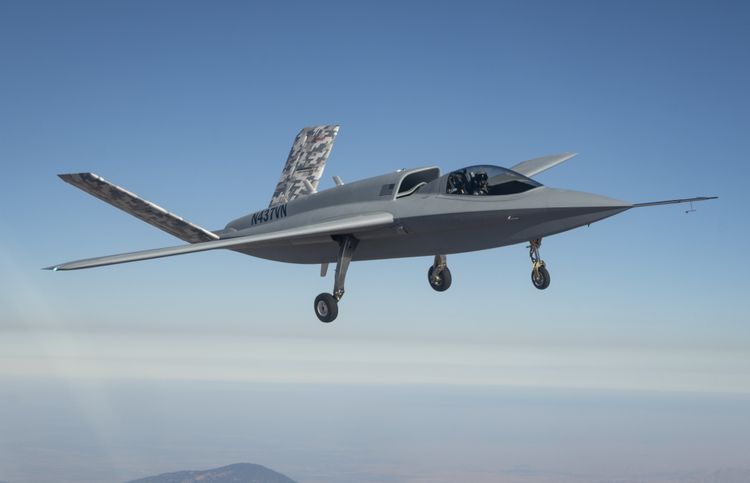Northrop Grumman’s Model 437 “Vanguard,” a potential demonstrator for the Collaborative Combat Aircraft program from subsidiary Scaled Composites, made its first flight from the company’s Palmdale, Calif., plant on Aug. 29. The company said the aircraft demonstrates the effectiveness of Northrop’s “digital ecosystem.”
Northrop first introduced Model 437 as a concept three years ago, touting it as a possible answer to the Air Force’s “loyal wingman” program—now called CCA—as well as a U.K. requirement for an attritable escort for F-35s. Since then, however, it has been tight-lipped about the project, and in announcing the aircraft’s first flight made no mention of CCA.
“The Model 437 began as a conceptual design, based on the Model 401, exploring a multi-mission, low-cost, attritable aircraft,” Northrop said in its release. The Model 437 is “a crewed variant of the original concept, powered by a single Pratt & Whitney 535 engine, with approximately 3,400 pounds of thrust.” After envelope expansion, it will have a range of approximately 3,000 nautical miles and endurance of six hours, Northrop said.
The company added that the aircraft can carry a payload of up to 2,000 pounds “in multiple locations” including two AIM-120 Advanced Medium Range Air-to-Air Missiles (AMRAAMs).
In its own release, Scaled said the Model 437 “leveraged extensive experience in rapid design, fabrication, and test of experimental aircraft.” In this case, it involved a “clean-sheet aircraft design, aerodynamic and structural analysis, fuselage and empennage fabrication, aircraft assembly, systems integration, and ground and flight test execution.” It described the first flight as “uneventful.”
Northrop also touted the digital framework underlying the Model 437—which carried a pilot on its first flight—as a product of collaboration between “the customer and supplier users.” Together, they developed, analyzed, built, and tested the wings of the aircraft, the company said. Northrop was not immediately able to explain why the aircraft is crewed, although industry officials have suggested the pilot could be there to be a hands-off safety supervisor as the jet tests out various autonomous flight programs.
“The Digital Pathfinder project demonstrated how the company’s fully digital engineering ecosystem reduces engineering rework, accelerates schedule and reduces costs, offering advantages to customers on future aircraft programs,” Northrop said. It employs “real world experience gained on programs like the B-21 Raider,” the Air Force’s new stealth bomber.
Colin Miller, vice president of Northrop’s aeronautics systems, said the company is working to “continuously improve” its digital tools and capabilities.
“This project demonstrates how high-fidelity models within our digital ecosystem serve as a single source of truth to streamline testing and certification on future aircraft, significantly saving cost and time for our customer,” Miller said.
Presumably referring to the Model 437, the company said digital methods “cut engineering rework and redesign to less than one percent, compared to the 15-20 percent experienced using traditional methods.” In the future, these methods could “significantly reduce the workload required to determine airworthiness, offering further cost and schedule savings opportunities.”
Northrop says Model 437 measures 41 feet by 41 feet and has a 10,000 pound maximum takeoff weight. It can accommodate a single pilot and fly at 25,000 feet.
Northrop said the aircraft also pioneers a new additive manufacturing process which produced “a titanium structural bracket using plasma arc energy deposition.” Northrop said it believes this method of forming a titanium part is a first in the defense industry. The method reduces the need for hard tooling, accelerating the prototyping process, while “improving first-time quality.”
The digital ecosystem used for the Vanguard “connected engineers, customers, and stakeholders in a virtual environment, allowing them to proactively foresee and solve the types of problems that typically plague acquisition programs up front and early—greatly improving program performance,” Northrop said.
In a press conference in 2021, Northrop officials posited a cost for the Model 437 of $5 million to $6 million per copy if it was put into series production. Company officials said the aircraft could achieve a speed of .85 Mach, making it capable of keeping up with F-35s enroute to a target, and said it would need less than 3,000 feet to take off.
The Air Force has adjusted its thinking on the CCA in the last few years, and now envisions the aircraft as performing escort functions for fighters but also carrying out independent missions. The first mission the Air Force plans for CCAs is as an air-to-air combat platform, likely carrying additional missiles that can be targeted by crewed fighters, but also able to select and fire air-to-air missiles autonomously.
Northrop was not chosen for the first increment of CCA—which went to Anduril, with its “Fury” aircraft, and General Atomics, with a variant of its XQ-67A Off Board Sensor System—but the company is competing for the CCA Increment 2, for which a downselect could come as early as 2026.


